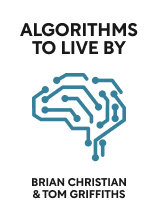

This article is an excerpt from the Shortform book guide to "Algorithms to Live By" by Brian Christian and Tom Griffiths. Shortform has the world's best summaries and analyses of books you should be reading.
Like this article? Sign up for a free trial here .
What is Brian Christian’s and Tom Griffith’s book Algorithms to Live By about? What is the key message to take away from the book?
Algorithms to Live By is an instruction manual for life: a collection of unconventional wisdom drawn from the field of computer science. Computers and humans share many of the same problems, and the same solutions that have allowed us to optimize the field of computing may be the ticket to optimizing our own lives.
Below is a brief overview of Algorithms to Live By: The Computer Science of Human Decisions.
Algorithms to Live By: The Computer Science of Human Decisions
In their book Algorithms to Live By, Brian Christian and Tom Griffiths make the case that computer science, a field that’s typically seen as highly specialized, actually contains a wealth of practical knowledge we can use to improve our lives. Computers can process tasks with blinding efficiency and quickly come up with creative solutions to complex problems. The authors of Algorithms to Live By argue that, by utilizing the same strategies as computers, we can do the same.
The authors assert that this is true because humans and computers face very similar problems. Both humans and computers are motivated to use their limited resources (which include memory, attention, and time) as optimally as possible. Consequently, many of the algorithms, or sets of instructions, that computers use to solve their problems work just as well in our own lives.
We’re going to discuss all eleven of Christian and Griffiths’s “algorithms to live by,” which we’ve divided into four categories: First, we’ll take a look at algorithms intended to help you make better decisions. Second, we’ll detail some algorithms to help you organize your life. Third, we’ll show off algorithms to help you solve difficult problems. Finally, we’ll discuss a couple of miscellaneous algorithms that don’t fit into the other categories.
| Is the Brain Really a Computer? Christian and Griffiths aren’t the first to compare the brain to a computer as the basis for their argument—researchers have been using this analogy for decades. Today, the question of whether or not we should view the brain as a complex computer is at the heart of a fierce debate. Some experts claim that the metaphor is limiting insights on the cutting edge of neuroscience more than it’s aiding them. They poke holes in the metaphor, pointing out ways in which the brain behaves unlike a computer and arguing that such inaccuracies will lead researchers to misguided assumptions. On the other hand, other experts argue that the brain-as-computer metaphor has not yet outlived its usefulness. In their eyes, it doesn’t matter if the brain doesn’t act like a computer—what matters is the fact that the brain accomplishes many of the same functions as computers do: It intakes, processes, and exports information. The fact that your brain computes makes it a computer. |
Algorithm #1: How to Know When to Settle
Christian and Griffiths’s first algorithm is: To choose the best from a series of options, explore without committing for the first 37%, then commit to the next top pick you see. This algorithm is designed to solve something mathematicians call an “optimal stopping problem”—when faced with a series of options, when do you settle down and commit to the opportunity in front of you if you don’t know what opportunities will be available in the future?
For example, imagine you’re looking for a job and know your skills are in high demand. After a couple of days of searching, you receive an offer out of the blue that’s better than any of the available positions you’ve seen so far. However, it doesn’t have everything you’re looking for. Do you take it or keep searching for better options?
According to Christian and Griffiths, statisticians have determined that the optimal way to solve this problem is to initially reject all opportunities, exploring your options to get a sense of what quality looks like. Then, at a certain point, commit to the next option that’s better than any you’ve seen so far. By calculating the probability that you pick the best option available for every possible “pivot point” from exploration to commitment, researchers have determined that you should explore for the first 37% of options, then commit to the next best opportunity.
Algorithm #2: How to Optimize Your Life
Christian and Griffiths’s next algorithm is a broader directive that applies to any area of your life you want to improve: To optimize your life, pursue whatever opportunity has a chance to be the greatest.
The authors frame life as a complex “multi-armed bandit” problem, referring to a model computer scientists use in machine learning. The multi-armed bandit is a theoretical experiment in which a decision-making agent is presented with a row of slot machines (“one-armed bandits”) and must try out different machines, learning from the outcomes to figure out which will pay off the most.
Christian and Griffiths explain that the multi-armed bandit problem’s optimal solutions are called “Upper Confidence Bound” algorithms, which recommend making decisions based on your options’ best-case scenarios. Pursue whatever opportunity in life has the potential to pay out the most, even if you think it’s extremely unlikely, since the only way to know for sure whether or not it’ll pay off is to test it yourself. Then, if you’ve given something a shot and determined that it’s not worth your while, adjust accordingly and shoot for the moon somewhere else.
Algorithm #3: How to Predict the Future
The next algorithm posed by Christian and Griffiths addresses the problem of an unpredictable future: To make better predictions, first, use your prior knowledge of the situation to estimate the chances of something happening, then adjust based on observable data. This strategy of using your prior beliefs to analyze the evidence you have is called “Bayes’s Rule.”
For example, if you want to predict when you’ll receive a raise at work, you might begin by asking a coworker how long it took for them to get a raise, then adjust that estimate based on how you think your boss views your performance.
Algorithm #4: Why You Should Make Less Informed Decisions
Christian and Griffiths’s final algorithm to aid decision-making is as follows: To make better decisions, consider less information.
With this algorithm, the authors address the problem of overfitting. In statistics and machine learning, “overfitting” occurs when a model takes too many variables into account, resulting in faulty understanding. Christian and Griffiths argue that, in the same way, if you consider too many variables when making a decision, you’ll “overfit,” overestimating the impact of insignificant information and underestimating the details that really matter.
According to Christian and Griffiths, the trick to conquering overfitting is to consciously restrict the amount of information you consider when making decisions. Identify one or two factors that matter the most and ignore everything else. For example, you may decide what job to take solely based on how much you expect to enjoy the work.
Algorithm #5: How to Schedule Your Time
Unlike in other chapters, Christian and Griffiths don’t offer a single algorithm to handle scheduling. Computers use algorithms chosen for their specific needs to determine what tasks to focus on first. Likewise, the authors state that your optimal scheduling algorithm differs based on your goals and priorities.
Christian and Griffiths assert that most of the time, your highest priority is to complete whatever tasks earn you the most value. They advise you to assign a “weight,” a numerical measurement of value, to every item on your to-do list. By dividing this weight by the amount of time it’ll take you to complete the task, you can easily calculate how much value you’re generating every hour that you’re working. Then, you should simply work at any given time on whatever gives you the most value per hour.
Another scheduling algorithm Christian and Griffiths recommend is “Shortest Processing Time,” which tells you to work on whatever task will take the shortest time to complete. The authors argue that you may choose to use this algorithm if you require motivation, or if you’re stressed and overwhelmed by a large quantity of tasks.
Algorithm #6: How to Organize Your Belongings
Christian and Griffiths’s next algorithm is intended to give you easy access to the things you need: To efficiently access any collection, segment it based on frequency of use.
Computers can efficiently search their vast stores of data by grouping what needs to be accessed most frequently and searching these “caches” first. In the same way, Christian and Griffiths recommend you “cache” your physical belongings by creating small piles of your most frequently used clothes, books, and files within arm’s reach of where you’ll need them.
Algorithm #7: How to Sort Like a Computer
Christian and Griffiths’s final organizational algorithm dictates the most efficient way to sort a group of items into a specific order. They argue that we should use the same sorting algorithms computers use to arrange files to efficiently sort physical collections in our own lives.
The best sorting strategy Christian and Griffiths have to offer is to first divide the collection into small categories, then rearrange individual items—a computer algorithm known as “Bucket Sort.” This algorithm is based on the fact that sorting gets more difficult with scale. Sorting a large group takes significantly more time than sorting four groups one-fourth of its size.
For example, if your boss were to ask you to sort twenty years’ worth of old archived meetings on VHS by date, you would want to use a Bucket Sort: First, divide them into piles by year, then arrange the smaller piles by hand.
Algorithm #8: How to Solve Impossible Problems
The world is incredibly complex, and many problems are literally impossible to precisely solve. Christian and Griffiths argue that the best way to solve problems like these is to strategically embrace imperfection.
Even when experts use computers to make exact calculations, they often trade away accuracy to save time. From this, Christian and Griffiths conclude that simply lowering your standard for success is often necessary to keep moving forward. In some cases where it’s impossible to find the perfect solution, getting close is just as good.
In other cases, Christian and Griffiths suggest you employ the mathematical problem-solving strategy of “constraint relaxation.” By removing some constraints and solving an easier version of your problem, you spark new ideas to help solve the original problem.
Algorithm #9: How to Solve Your Problems by Acting Randomly
Christian and Griffiths’s next algorithm is all about the power of randomness: To move past dead ends, act randomly.
The authors explain that computers use something called the “hill-climbing” algorithm to solve problems. They calculate a solution, then slowly improve it by testing out small adjustments. When developing their problem-solving strategies, people naturally follow a similar process. However, both computers and humans run into the same issue with hill climbing: Eventually, they hit a “local maximum”—a solution that can’t be improved by small adjustments yet is far from the best solution available.
According to Christian and Griffiths, the way to escape local maxima is an injection of irrational randomness. By making a few random, intentionally suboptimal decisions, you can discover new solutions you couldn’t see before and get unstuck. Feeling stagnant and directionless in life? Pick up a random new hobby or move to a random new town.
Algorithm #10: How to Use Game Theory
This next algorithm shows us how we should view the rules that govern our society: To prevent collective harm, design the rules of the game to create win-win scenarios.
Christian and Griffiths explain that we can view many systems in our society as competitive games and analyze them using game theory. In game theory, a “Nash equilibrium” occurs when every player has settled into the best possible strategy available to them, stabilizing its outcome. According to the authors, it’s the job of policymakers to ensure that the system’s Nash equilibrium results in an outcome that benefits all players—a process known as “mechanism design.”
For example, laws that regulate overfishing are meant to adjust the Nash equilibrium of the “game’ of commercial fishing. If unregulated, the optimal strategy for each fisher is to catch and sell as many fish as possible. Unfortunately, the fishers in this Nash equilibrium may drive a population of fish to extinction, which harms all players. By penalizing overfishing, the laws cause sustainable fishing to become the new optimal strategy, creating a new Nash equilibrium.
Algorithm #11: How to Enhance Communication
To conclude, we’ll cover an algorithm that Christian and Griffiths draw from the Internet’s networking protocols: To communicate effectively, listeners need to signal that they’ve received the message.
The authors explain that when a computer connects to a server, both sides exchange “acknowledgment packets,” or “ACKs,” to ensure that the connection is stable. These are short messages that tell the other computer that its message has been received. These ACKs are a vitally necessary part of the communication process, and they make up a huge portion of all uploaded data.
Christian and Griffiths assert that, similarly, acknowledgment is an extremely important part of human communication, and it’s one that we often overlook. Recent research in the field of linguistics has put renewed focus on “backchannels,” a listener’s short interjections that acknowledge a speaker’s message without ending their turn to speak. It takes more than being quiet and polite to be a good listener—if you don’t give active feedback, communication falls apart.

———End of Preview———
Like what you just read? Read the rest of the world's best book summary and analysis of Brian Christian and Tom Griffiths's "Algorithms to Live By" at Shortform .
Here's what you'll find in our full Algorithms to Live By summary :
- How to schedule your to-do list like a computer
- Why making random decisions is sometimes the smartest thing to do
- Why you should reject the first 37% of positions in your job search






